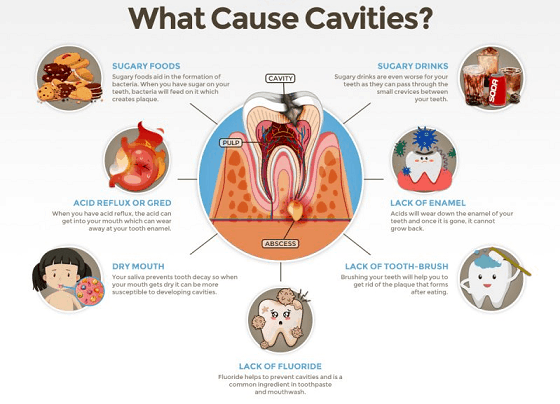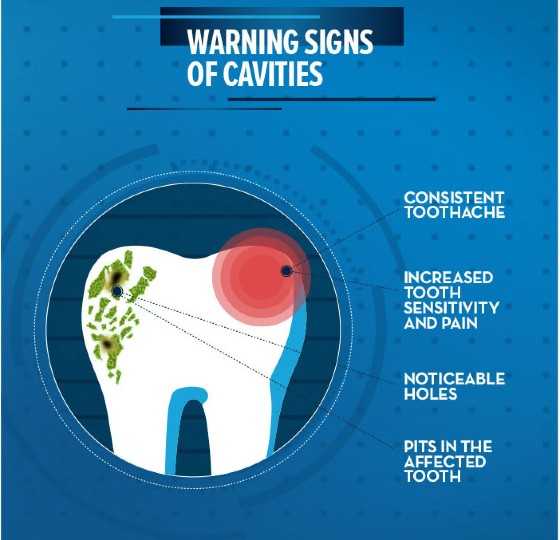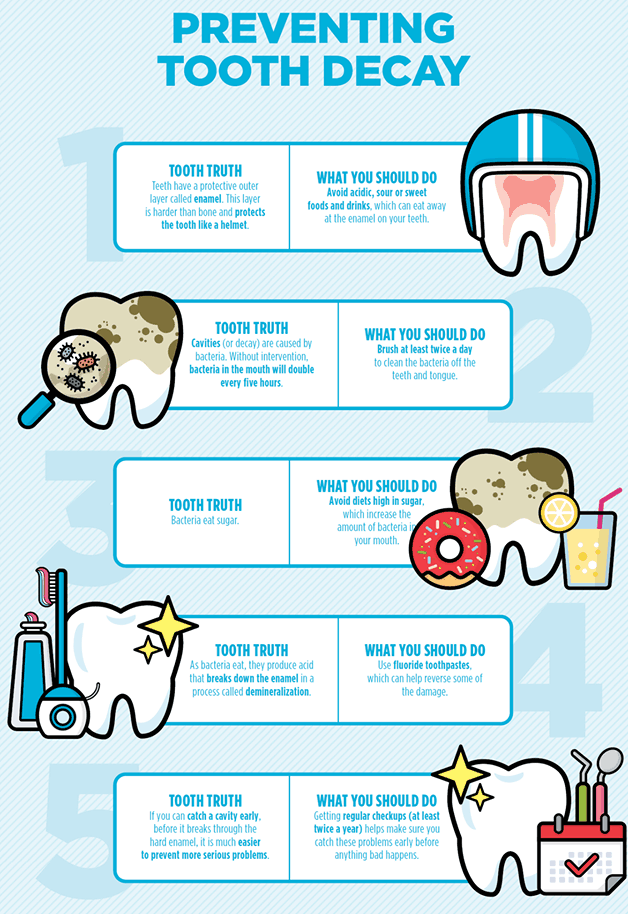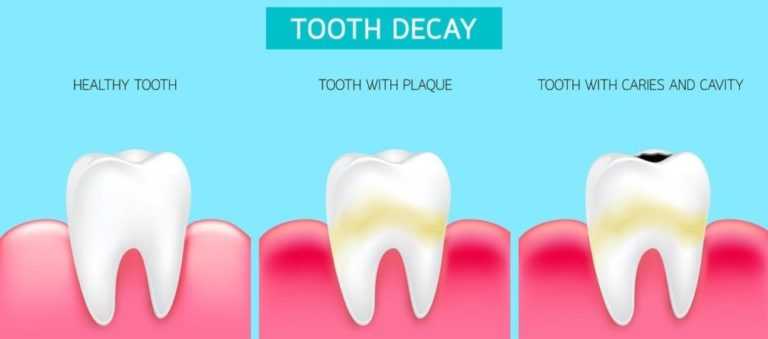What is tooth decay?
Tooth decay is dental damage caused to the tooth or the enamel. It happens because of the settled bacteria that make the acid turn in to infection and attack the enamel. Tooth decay can lead to cavities which are deep holes in your teeth. If tooth decay is not treated, it can cause pain, infection, and even lead to tooth loss.
Tooth decay causes
Our mouth is full of bacteria. Some bacteria are helpful and some can damage oral health. These bacteria combine with food, soft sugary drinks, that creates plaque. The bacteria in plaque use the sugar and starch in what you eat and drink to make acids.
The acids start decaying and begin to eat away all the minerals on your enamel. Over time, the untreated plaque can harden into tartar. Besides damaging your teeth, plaque and tartar can also irritate your gums and cause gum disease .

You get fluoride from toothpaste, water, and other sources. The contained fluoride along with saliva helps to repair the enamel by replacing the minerals. Your teeth go through this natural process of losing minerals and regaining minerals all day long.
But if you don’t take care of your teeth and/or you eat and drink lots of sugary or starchy things, your enamel will keep losing minerals and this will lead to tooth decay. White spots on the teeth appear once the minerals are lost. This is an early sign of tooth decay. You may be able to stop the decay at this point.
Your enamel can still repair itself only when better care of your teeth and limit sugary/starchy foods and drinks.
If the minerals totally affect the mouth, tooth decay takes a major turn. In such a case, enamel gets weak and destroyed, leading to the formation of the cavity. A cavity is a hole in your tooth. It is permanent damage that a dentist has to repair with a filling.
Who is at risk for tooth decay?
The main risk factors for tooth decay are not taking care of your teeth and having too many sugary or starchy foods and drinks.
Some people have a higher risk of tooth decay, including people who
- Don’t have enough saliva
- Don’t get enough fluoride
- This occurs at a very young age. .
- Occurs at an older age
What are the symptoms of tooth decay and cavities?
In early tooth decay, you usually don’t have symptoms. As tooth decay gets worse, it can cause

- A toothache
- Tooth sensitivity due to sweets, hot, or cold
- White or brown stains on the surface of a teeth
- A cavity
- An infection, which can lead to pus. This abscess causes pain, facial swelling, and fever.
How are tooth decay and cavities diagnosed?
Firstly the dentist will go through the mouth and search for the decay and cavities. Your dentist will also ask if you have any symptoms. Sometimes you may need a dental x-ray.
What are the treatments for tooth decay and cavities?
There are several treatments to improve tooth decay and cavities. Which treatment you get depends on how bad the problem is:
- Fluoride treatments. If you have early tooth decay, a fluoride treatment can help the enamel to repair itself.
- Fillings. If you have a typical deep cavity, your dentist will remove the decayed tooth tissue and then restore the affected tooth by filling it with a filling material.
- Root canal. If the infection spreads to the pulp of the tooth, you might need a root canal. Your dentist will remove the decayed pulp and clean inside the tooth and root. The next step is to fill the tooth with a temporary filling. Then you will need to come back to get a permanent filling or a crown that will protect the tooth
- Extraction (pulling the tooth). In the most severe cases, when the damage to the pulp cannot be fixed, your dentist may pull the tooth.

Can tooth decay be prevented?
There are steps through which you can prevent the problem of tooth decay:
- Make sure that you get enough fluoride your teeth by
- Brushing with a fluoride toothpaste
- Drinking tap water with fluoride. Most bottled water does not contain fluoride.
- Using a fluoride mouth rinse
- Practice good oral health by brushing and flossing your teeth at least twice a day with fluoride toothpaste.
- Try to eliminate sugary food and drinks from your diet. Eat nutritious, balanced meals, and limit snacking.
- Do not use tobacco products, including smokeless tobacco. If you currently use tobacco, consider quitting.
- See a dentist at least once in six months for regular check-ups and professional teeth cleanings.
- Children with cavities should immediately get sealants on their teeth. Dental sealants are thin plastic coatings that protect the chewing surfaces of the back teeth. Children should get sealants on their back teeth as soon as they come in before decay can attack the teeth.
Expert opinion
- Dr. Rupali Gujar Dental Director of Sabka dentist says “Tooth decay is not a normal problem it may result in tooth loss and other major dental issues. Hence, it is advised to take prior precautions to save the tooth from further loss. ”
References
Frequently Asked Question
How to stop tooth decay from spreading
- Brush with fluoride toothpaste after eating or drinking.
- Rinse your mouth with lukewarm saltwater.
- Visit your dentist twice a year for a regular dental check-up.
- Avoid frequent snacking and sipping.
- Eat tooth-healthy foods.
- Avoid spicy and junk food.
Home remedies for tooth decay
Salt
Salt has antibacterial and antiseptic properties present in it. This makes salt more effective in treating tooth decay. Salt can reduce infection and prevent the growth of bacteria in the mouth. Rinse with salt and lukewarm water once a day to improve your oral health.
Oil Pulling
Oil pulling is a traditional method for enhancing oral health. It kills all the harmful bacteria in the mouth responsible for tooth decay.
Take one tablespoon of oil(Sunflower, coconut or sesame oil) and swish it in your mouth for a few minutes. Spit it and rinse your mouth with salt and lukewarm water.
Garlic
Garlic is rich in antibacterial and antibiotic properties. Garlic is also very effective in treating tooth decay and cavities. Crush 3-4 garlic cloves and 1/4 teaspoon of pink salt and prepare a paste and apply it to the tooth.
Apply it for 10 minutes and then rinse with salt and lukewarm water.





